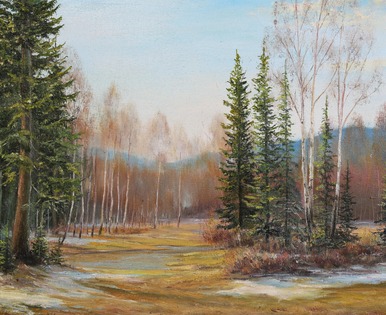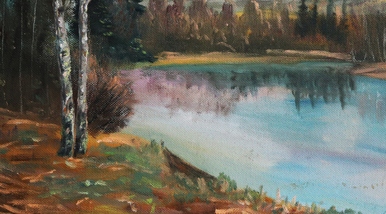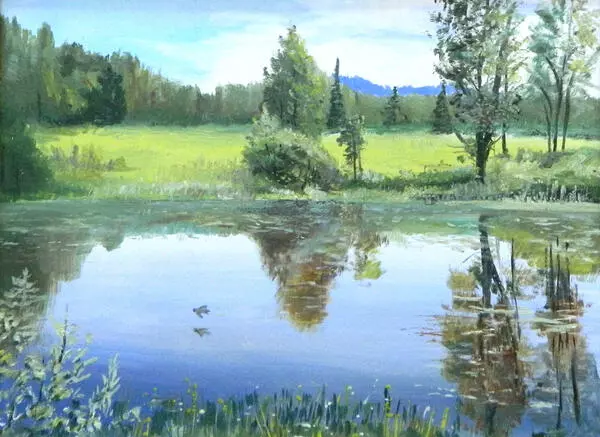Vladimir Kirillovich Gomenko, an artist from Mezhdurechensk, had a lasting love for the striking beauty of his native region. He was a very active painter, often participating in local plein-air competitions, and almost always had his paints and easel by his side. He loved to paint from life. In his work he depicted the distant mountains merging with the sky, the magical forests and the crystal-clear rivers of his region. Vladimir Gomenko’s paintings are filled with silence and harmony.
In The Romantika Health Resort we see a picturesque spot not far from the city of Mezhdurechensk. In the foreground there is a lake shore, with tall grass and meadow flowers. Behind it, in the middle ground, is a
beautiful lake, surrounded by forest on all sides. The trees are reflected in the surface of the lake, giving it a dark green tone. On the right we see a radiantly beautiful silver birch, with light green leaves.
And in the distance are hills, covered with thick vegetation. The light blue sky is covered with thin white cloud, painted in light pastel tones. The static composition conveys the atmosphere of silence and calm on a fine summer’s day. Through his skillful use of color, especially the contrast between dark and light greens and blues, the artist has achieved a highly realistic effect. The painting is full of light, air and space.
The Romantika Health Resort, the subject of this painting, is located in the Mountain Shoria region. This beautiful and bountiful region has long been home to the native Shorians, or Kuznetsk Tatars, who settled in its forests. The types of work traditionally done by the indigenous people are dictated by this low mountain landscape, with its dense spruce and cedar forest, and its lakes and its rivers, with their numerous tributaries.
They smelted ores, forged metal, hunted and fished. Nature has been generous in its gifts to the local residents. Mountain Shoria’s many rivers are rich in grayling, taimen (a type of salmon), dogfish, orfe and pike. In the past the forests had many large mammals, including elk, deer, moose and bears. There were also many animals hunted for fur — sable, otters and squirrels.
The indigenous Shorians followed shamanism — they worshipped Nature and honored the spirits of the mountains, lakes, rivers and forests. Before setting out on a fishing trip, the Shorians used to pray for good luck to the water spirit Sug-Eezi. When setting out on a hunting trip, the hunters poured out offerings of drink to the spirit Tag-Eezi at the foot of the mountain.
The local people venerated various species of tree, which were seen as intermediaries between the forest world and humans. When they arrived at a hunting site, the Shorians began by choosing a mighty cedar or spruce tree and making a sacrifice to it in order to ask the holy tree for success in their undertaking. The local people particularly venerated birch trees.
In this work Vladimir Gomenko vividly depicts the mysterious natural beauty of this land of mountains and forests.
In The Romantika Health Resort we see a picturesque spot not far from the city of Mezhdurechensk. In the foreground there is a lake shore, with tall grass and meadow flowers. Behind it, in the middle ground, is a
beautiful lake, surrounded by forest on all sides. The trees are reflected in the surface of the lake, giving it a dark green tone. On the right we see a radiantly beautiful silver birch, with light green leaves.
And in the distance are hills, covered with thick vegetation. The light blue sky is covered with thin white cloud, painted in light pastel tones. The static composition conveys the atmosphere of silence and calm on a fine summer’s day. Through his skillful use of color, especially the contrast between dark and light greens and blues, the artist has achieved a highly realistic effect. The painting is full of light, air and space.
The Romantika Health Resort, the subject of this painting, is located in the Mountain Shoria region. This beautiful and bountiful region has long been home to the native Shorians, or Kuznetsk Tatars, who settled in its forests. The types of work traditionally done by the indigenous people are dictated by this low mountain landscape, with its dense spruce and cedar forest, and its lakes and its rivers, with their numerous tributaries.
They smelted ores, forged metal, hunted and fished. Nature has been generous in its gifts to the local residents. Mountain Shoria’s many rivers are rich in grayling, taimen (a type of salmon), dogfish, orfe and pike. In the past the forests had many large mammals, including elk, deer, moose and bears. There were also many animals hunted for fur — sable, otters and squirrels.
The indigenous Shorians followed shamanism — they worshipped Nature and honored the spirits of the mountains, lakes, rivers and forests. Before setting out on a fishing trip, the Shorians used to pray for good luck to the water spirit Sug-Eezi. When setting out on a hunting trip, the hunters poured out offerings of drink to the spirit Tag-Eezi at the foot of the mountain.
The local people venerated various species of tree, which were seen as intermediaries between the forest world and humans. When they arrived at a hunting site, the Shorians began by choosing a mighty cedar or spruce tree and making a sacrifice to it in order to ask the holy tree for success in their undertaking. The local people particularly venerated birch trees.
In this work Vladimir Gomenko vividly depicts the mysterious natural beauty of this land of mountains and forests.




